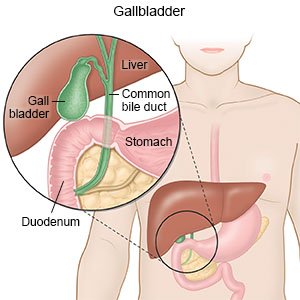Percutaneous Transhepatic Biliary Drainage
Medically reviewed by Drugs.com. Last updated on Apr 6, 2025.
What do I need to know about percutaneous transhepatic biliary drainage (PTBD)?
PTBD is a procedure to open a blocked bile duct.
 |
How do I prepare for a PTBD?
- Your healthcare provider will tell you how to prepare for the procedure. He or she may tell you not to eat or drink anything after midnight before the procedure. Arrange to have someone drive you home from the procedure.
- You may need to follow a certain diet before your procedure. You may need to see a dietitian who will teach you which foods to eat and which foods to avoid. If you drink alcohol, you may need to stop.
- Tell your provider about all medicines you currently take. He or she will tell you if you need to stop any medicine for the procedure, and when to stop. He or she will tell you which medicines to take or not take on the day of the procedure.
- You may need to have blood tests and an EKG. You also may need x-rays, an ultrasound, a CT scan, or an MRI.
- You may be given antibiotics to help prevent a bacterial infection. Tell your provider if you had an allergic reaction to an antibiotic.
- You may have endoscopic retrograde cholangiopancreatography (ERCP) before your procedure. ERCP can help your provider plan your procedure. He or she may also remove stones or growths in your bile duct.
What will happen during PTBD?
- You may be given general anesthesia to keep you asleep and free from pain during the procedure. You may instead be given local or spinal anesthesia to numb the area. A CT scan or fluoroscopy may be used during the procedure. Your healthcare provider will put a needle through the right side of your abdomen and into your liver. A wire will be pushed through the needle and into your liver.
- Your provider will use the wire to break up the stones that block your bile duct. He or she will put a tube over the needle and then remove the needle and wire. The tube will be left in place. A small part of the tube will come through your skin to the outside of your body. If the tube is capped, bile will drain into your intestines. If the tube is left open, bile will drain into a bag that is attached to the end of the tube outside of your body.
What should I expect after PTBD?
You will be taken to a room to rest until you are fully awake. You will be monitored closely for any problems. Do not get out of bed until your healthcare provider says it is okay.
- You will be helped to walk around after surgery. Movement helps prevent blood clots.
- Medicine may be given to prevent or treat pain or nausea.
What are the risks of a PTBD?
Your gallbladder, bile duct, or blood vessels may be damaged. You may bleed more than expected. After the procedure, you may have swelling or bleeding around the tube. The skin around the tube may get infected. The tube may move out of place or get blocked. Your gallbladder may become swollen or infected. You could develop a blood clot in your liver or a lung infection. Your lungs could fill with blood or air, making it hard for you to breathe.
Care Agreement
You have the right to help plan your care. Learn about your health condition and how it may be treated. Discuss treatment options with your healthcare providers to decide what care you want to receive. You always have the right to refuse treatment. The above information is an educational aid only. It is not intended as medical advice for individual conditions or treatments. Talk to your doctor, nurse or pharmacist before following any medical regimen to see if it is safe and effective for you.© Copyright Merative 2025 Information is for End User's use only and may not be sold, redistributed or otherwise used for commercial purposes.
Further information
Always consult your healthcare provider to ensure the information displayed on this page applies to your personal circumstances.
